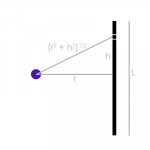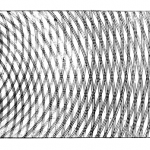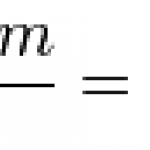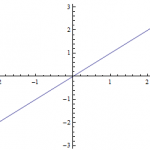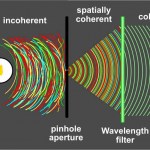
Ladies and gentlemen, I give you the worst physics news article I have ever seen:
Freaky Physics Proves Parallel Universes Exist
Every word in the title is wrong but "physics". It's not freaky, doesn't prove anything we didn't already know, and has nothing to do with parallel universes nor does it shed any light the question of their possible existence.
Look past the details of a wonky discovery by a group of California scientists -- that a quantum state is now observable with the human eye -- and consider its implications: Time travel may be feasible. Doc Brown would be proud.
Quantum…
Happy Easter, everyone!
This Sunday Function is going to be short and sweet, since unfortunately I've got a lot to do before Monday. Let's get down to business!
Here's a function I've made up out of thin air. It's pretty arbitrary - in fact, it's discontinuous at x = -1/2 and not differentiable at x = 0:
Here is a huge pile of sine and cosine waves, with one bonus constant line which, if you'd like, you can think of as a cosine wave with infinite wavelength:
And here is what you get if you add all of those waves together and graph the result:
It looks quite a bit like the random crazy…
There's a classic problem in physics textbooks which asks you about astrology. It's sometimes said - the problem will tell you - that the gravitational pull of the doctor delivering you is stronger than that of Jupiter, therefore it's unlikely that the planets are exerting a whole lot of influence on your life. The problem asks you to check this.
Of course gravity is not generally purported to be the conduit of the supposed influence of the zodiac, but it's an interesting problem. And in fact it will turn out that Jupiter generally has the doctor beat, but not by that much. It's a neat…
So what exactly is light, anyway?
It's a tough question. Isaac Newton thought it was composed of streams of microscopic particles he called corpuscles. Really it wasn't a bad idea. Light rays travel in straight lines just like fast moving projectiles, light bounces off objects in a manner not entirely unlike a ricocheting bullet, and if you try hard enough you can even explain refraction in terms of particles being slowed in matter online the lines of a ball bearing sinking in molasses.
But it's pretty hard for the particle view to explain diffraction and interference, which are both very…
If you happen to be in the Bryan/College Station area tomorrow, you might consider checking out the Texas A&M Physics Festival. It's sort of an open house with a ridiculous number of top-notch physics demonstrations as well as some very interesting talks. It's free! I'll be there helping out with some of the optics demos.
While we're here, we may as well do some physics. This problem is from Halliday, Resnick, and Walker 14.62. It asks (fitting well with the space stealth theme from earlier):
One way to attack a satellite in Earth orbit is to launch a swarm of pellets in the same…
Somehow - and I don't know exactly how, you know how the internet is - I came across this odd but cute song by the ineffable Weird Al. It's an almost seven-minute(!) ode to the roadside attraction that is the titular biggest ball of twine. The twine ball actually exists, and lives in Darwin, Minnesota.
Oh! What on earth would make a man decide to do that kind of thing!
Oh! Windin' up twenty-one thousand, one hundred forty pounds of string!
...
You know, I bet if we unravelled that sucker,
It'd roll all the way down to Fargo, North Dakota
'Cause it's the biggest ball of twine in Minnesota…
This is the graph of the line y = x:
If you put your finger down on any point on that line, and then put another finger on another point on that line, you find that the total change in the y-coordinate divided by the total change in the x-coordinate between those two positions is 1. Move two units to the right, and the line rises by two units, etc. This is the same no matter which two points you pick. Every line has this sort of property, which is called slope. Steep lines that rise greatly for each unit of x displacement have a large slope, flat horizontal lines have zero slope, and…
GrrlScientist sends a link to this rather wild stunt from India:
How is it possible? What kind of friction is necessary, and is it any more difficult for the cars to do the stunt than it is for the motorcycles?
Before we do any math, I want to think about the problem qualitatively. Let's tally up the forces acting on the vehicles. First, there's gravity. It points vertically downward, straight toward the center of the earth. Second, there's the normal force. "Normal force" means the force normal (in this context a physics technical term meaning perpendicular) to the surface. It's the…
Sine, cosine, and tangent are of course the workhorse functions of trigonometry. You learn 'em in high school, and if you go on in math and science you never stop using them. Now on many occasions you might have the sine or cosine or tangent of some angle, and you want a way to invert those functions to recover the angle from those values. Let's take a look at the inverse tangent function:
Now we'll do one of those things were we skip any motivation and just do some stuff for reasons we'll get to at the end. Let's find the derivative of the arctangent function. To start, take the…
In the Stealth in Space post earlier this week, we discussed the problem of detecting the thermal emission from a spacecraft. If the interior isn't generating a lot of power, there's not much thermal radiation being emitted, making it a tough job to detect.
But it was pointed out in the comments that the heat from the sun would itself warm the spacecraft exterior, increasing the thermal signature by potentially a large amount. Let's verify this. If you take a perfectly absorbing sphere and set it in orbit around the sun (say, at the distance of the Earth), it'll absorb all the light from…
While doing some poking around online, I came across a website called Project Rho, which tries to provide some science background for science fiction writers who want some degree of technical accuracy in their imaginative work. Generally it looks like they're on the right track.
In their section on stealth in space, they explain with the weary air of repetition that there's no such thing. The flare of a rocket is bright enough to be seen from basically anywhere, and the thermal signature of even a spacecraft with rockets off is visible from clear across the solar system. The first I can…
This Sunday I was at an event that involved a number of drawings for door prizes. There were perhaps 30 couples there - it was, not to beat around the bush, a wedding registry shindig at Bed, Bath, & Beyond. (Did I mention I'm recently engaged? I am. It's the main reason for the endemic light posting, as I'm afraid the wedding bumps the blog down the priority list a bit. ;) )
There was something in the vicinity of 8 or so drawings from separate bowls, and each couple's number was placed in each bowl. The rules were such that a couple could only win once. One number was pulled twice…
If you read about science at all, you've heard of Heisenberg's uncertainty principle. It's the canonical example of quantum weirdness, the strange idea that you can't simultaneously know the position and momentum of a particle. Pack a particle into a small enough box and your accurate knowledge of position will necessarily cause that particle to have a very uncertain momentum, "bouncing" around crazily inside that box.
What you may not have read is that this isn't just quantum weirdness, it happens just as often in the classical world of waves. In fact, the very fact that quantum particles…
There's an interesting science puff piece that's been circulating around various media outlets about the length of the day after the earthquake in Chile. At random, here's the NY Daily News version:
The quake that rocked the South American nation may have also knocked the Earth off its axis.
The 8.8-magnitude earthquake near Chile may have also made our planet's days shorter, according to NASA scientist Richard Gross.
A minor change in the Earth's axis isn't expected to alter much in terms of weather. The planet's tilt influences the seasons, allowing for winter, spring, summer and fall, and…
A reader writes in with a question about the speed of light. Since the meter and second are defined in terms of that speed, how would we be able to tell if the speed of light is changing or has changed throughout history?
It's a good question. According to the official standard, a meter is defined to be "the length of the path travelled by light in vacuum during a time interval of 1â299 792 458 of a second". If the speed of light gets faster, by definition the meter gets longer. It's additionally complicated by the fact that the second is also defined in terms of the speed of light. The…
Here's a simple function that's not so often found in mathematical physics, but it's still a nice showpiece for exhibiting some interesting behavior:
I've only plotted it for positive real x, because for x less than zero it starts spitting out complex numbers in a very unfriendly way. We're only considering it along the domain in which it's purely a real function. Just from the graph it's clear that this is a very fast-growing function. This isn't exactly a shock. 3^3 = 3x3x3 = 27, while 5^5 = 5x5x5x5x5 = 3125. Larger x produces much larger f(x) at an astonishing rate.
But just what…
Unfortunately it's rarely on TV more than once every four years, but I have to say I've really gotten to curling. Not only is it interesting to watch, it looks like it's actually a sport that could be played for fun at the beginning level. Unfortunately there doesn't seem to be a whole lot of curling in Texas for some reason, so I have to content myself with watching. And thinking about the physics.
The goal in curling is to end each round with your stones closest to the center of the ring. From the release point to the center of the ring is about 97 feet or so. Friction with the ice…
Grad school and a major (good) event in my personal life have been gobbling huge swaths of time, hence the comparative silence around here. I'm afraid we may be down to a few times a week for the next few months. I hope y'all'll bear with me. ("Y'all'll" is of course the standard contraction for "you all will", is it not?)
Still, there's always time for some physics now and then. Say you're presented with a box with two holes in the side. From one opening, a laser beam - say, HeNe red - from a laser in the box emerges. From the other, the light from a red hot object in the box emerges…
Pretty much every high school student can quote the formula for the area of a circle: it's A = pi r^2, where r is the radius. Most of them can do the same thing for the volume of a sphere: V = 4/3 pi r^3.
You could, if you wanted, generalize the concept and call circles "2-spheres", because they're the set of all points a given distance from the center in a 2d space. A sphere would be a "3-sphere", because it's the set of all points a given distance from the center in 3d space. A "1-sphere" would be the set of all points on a line equidistant from the center on a line. Of course there…
Recently I bought a plug-in power meter, along these lines:
It's a nice little invention to have. You can measure both instantaneous power consumption as well as total energy used. Given that and your power bill, you can see how much it costs to run a particular appliance in real time. The answer is usually "not much", since it doesn't really matter if a toaster oven uses 1500 watts but is only on for two minutes. On the other hand, a computer and monitor that use 300 watts but is on for hours ends up costing a significant amount over the course of a month.
Right now the power strip…

